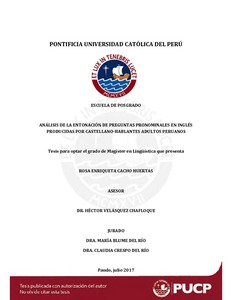| dc.contributor.advisor | Velásquez Chafloque, Héctor Hugo Gabriel | |
| dc.contributor.author | Cacho Huertas, Rosa Enriqueta | es_ES |
| dc.date.accessioned | 2017-09-14T15:29:42Z | es_ES |
| dc.date.available | 2017-09-14T15:29:42Z | es_ES |
| dc.date.created | 2017 | es_ES |
| dc.date.issued | 2017-09-14 | es_ES |
| dc.identifier.uri | http://hdl.handle.net/20.500.12404/9340 | |
| dc.description.abstract | En la presente tesis, se describe y compara la entonación de preguntas pronominales en
inglés, producidas por castellano-hablantes adultos peruanos (aprendices), y la entonación
de preguntas de este mismo tipo producidas por hablantes nativos de inglés (variedad
británica). El análisis de la entonación se realiza tomando como base el modelo métricoautosegmental.
La señal acústica, en este caso el tono de frontera final de la curva de
entonación, es analizada mediante el software PRAAT. Como variables, se consideran
factores tales como cantidad de input, edad de los aprendices e influencia de los patrones
de entonación de la L1 (castellano) en la L2 (inglés). El trabajo se realiza con la
participación de cuatro grupos. Los integrantes del primer grupo, quienes colaboraron
también como informantes de castellano como L1, cuentan con un input aproximado de
360 horas de aprendizaje de inglés. El segundo grupo tiene un input aproximado de 960
horas. En estos dos grupos, los participantes tienen entre 20 y 26 años de edad. Un tercer
grupo, al igual que el primero, cuenta también con 360 horas de input aproximadamente,
pero sus integrantes tienen entre 35 y 50 años de edad, todos castellano-hablantes
peruanos que aprenden inglés como L2 en un contexto formal. Estos grupos fueron
seleccionados por tener distintas edades y diferente tiempo de exposición al input en un
contexto formal, y por tener castellano como L1, características que posibilitan
determinar si existe influencia de los factores antes mencionados en la entonación.
Finalmente, el cuarto grupo está conformado por hablantes nativos de inglés de la
variedad británica, quienes constituyen el grupo de control, y cuyas edades varían entre
32 y 74 años. La investigación muestra que la edad de los aprendices tiene una influencia
significativa en la entonación de preguntas pronominales, mientras que el input y la L1 no
muestran una influencia significativa en la entonación de este tipo de preguntas. | es_ES |
| dc.description.abstract | In this thesis, the intonation of pronominal questions in English, produced by Peruvian
Spanish-speaking adults (learners), and the intonation of similar questions produced by
English native speakers (British variety) is described and compared. The analysis of the
intonation is made based on the autosegmental-metrical model. The acoustic signal, in
this case the final boundary tone of the intonation curve is analysed using the PRAAT
software. Factors such as input quantity, age of learners and influence of the intonation
patterns of L1 (Spanish) on L2 (English) are considered as variables. The investigation is
carried out with the participation of four groups. The members of the first group, who
also took part as Spanish L1 informants, have an approximate input of 360 hours of
English language learning. The second group has an approximate input of 960 hours. The
participants of these two groups are between 20 and 26 years old. The third group, like
the first, has also 360 hours of input approximately, but the participants are between 35
and 50 years old, all Peruvian Spanish-speakers who learn English as L2 in a formal
context. These groups were selected for having different ages and different exposure time
to the input in a formal context, and for having Spanish as L1, characteristics that make it
possible to determine if there is influence of the above mentioned factors in intonation.
Finally, the fourth group consists of British-English native speakers who represent the
control group and whose ages vary between 32 and 74 years. This investigation shows
that the age of learners has a significant influence on the intonation of pronominal
questions, while the input and L1 do not show a significant influence on the intonation of
such questions. | es_ES |
| dc.description.uri | Tesis | es_ES |
| dc.language.iso | spa | es_ES |
| dc.publisher | Pontificia Universidad Católica del Perú | es_ES |
| dc.rights | Atribución-NoComercial-SinDerivadas 2.5 Perú | * |
| dc.rights | info:eu-repo/semantics/openAccess | es_ES |
| dc.rights.uri | http://creativecommons.org/licenses/by-nc-nd/2.5/pe/ | * |
| dc.subject | Inglés--Estudio y enseñanza | es_ES |
| dc.subject | Lenguaje y lenguas--Estudio y enseñanza | es_ES |
| dc.subject | Bilingüismo | es_ES |
| dc.title | Análisis de la entonación de preguntas pronominales en inglés producidas por castellano-hablantes adultos peruanos | es_ES |
| dc.type | info:eu-repo/semantics/masterThesis | es_ES |
| thesis.degree.name | Magíster en Lingüística | es_ES |
| thesis.degree.level | Maestría | es_ES |
| thesis.degree.grantor | Pontificia Universidad Católica del Perú. Escuela de Posgrado | es_ES |
| thesis.degree.discipline | Lingüística | es_ES |
| renati.discipline | 232137 | es_ES |
| renati.level | https://purl.org/pe-repo/renati/level#maestro | es_ES |
| renati.type | http://purl.org/pe-repo/renati/type#tesis | es_ES |
| dc.publisher.country | PE | es_ES |
| dc.subject.ocde | https://purl.org/pe-repo/ocde/ford#6.02.06 | es_ES |






